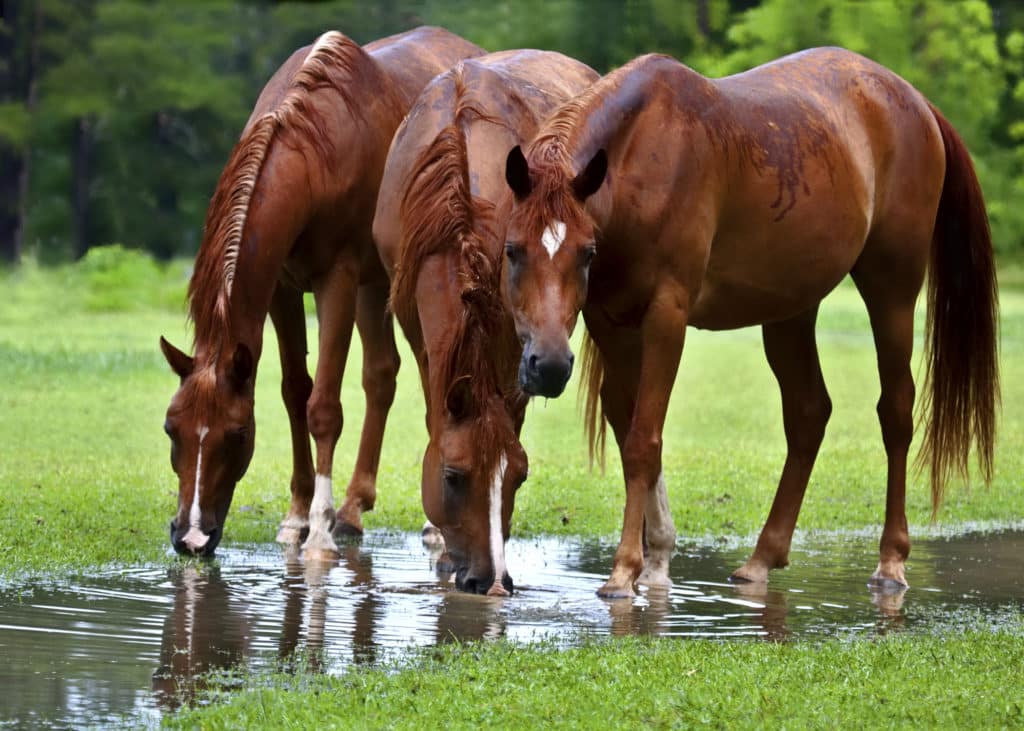Equine Health, Equine Lifestyle
Rain Scald in Horses: Treatment & Prevention
Winter is notoriously wet in the UK. When the cold weather and shorter days roll around, we’re typically met with constant rain, which means our fields soon turn into bogs and our horses become literal mud monsters. Aside from making horse ownership rather unpleasant, our damp winters also bring about a variety of issues, one of which being rain scald in horses.
What is rain scald in horses?
Also known as rain rot, rain scald is a bacterial infection of the skin that causes matted scabs to form around the back, head, neck, flanks, and rump. When the condition is localised to just the legs it’s known as mud fever. Much like mud fever, rain scald can occur all year round but it’s most common in autumn and winter due to the prolonged periods of wet weather.
What causes rain scald?
Rain scald in horses is caused by the bacteria “Dermatophilus Congolensis” which typically enters the surface layer of horses’ skin when it’s exposed to prolonged wetting and cracking, resulting in an infection. It’s most commonly seen in horses that are kept outside in wet and muddy conditions as the bacteria originates in soil, but it can also live on the skin and when the surface is compromised, it can cause infection.
Interestingly, the bacteria that causes rain scald can be passed from horse to horse by flies, sharing rugs and tack and even grooming equipment. If you suspect a horse has rain scald, never share their equipment and be sure to disinfect it before coming into contact with another equine.
Light coloured horses tend to be more susceptible which is thought to be due to their pink skin which is more delicate. Additionally, horses with poorly developed immune systems or underlying diseases such as cushing’s disease are more prone to getting rain scald.
Recognising the signs of rain scald in horses
Rain scald in horses will typically present as the following:
• Scabs with tufts of hair attached to them, this hair may stand up and look similar to paint brush bristles
• These scabs are typically painful, so make sure you leave them alone and don’t pick at the area
• Yellow pus may be present beneath the scabs
• In severe cases, there may be large areas of scabbing which merge together, resulting in a very coarse coat
If you notice the above signs, it’s important to contact your vet for diagnosis.
How is rain scald in horses diagnosed?
Your vet will carry out a full examination of your horse’s skin and their scabs, this will typically be enough for them to make an accurate diagnosis. If they’re unsure of the cause of the skin issue – in the early stages rain scald can be confused with ringworm or seborrhoea – they may take a sample from a swab or scab to be cultured in a lab to see if the bacteria grows.
Rain scald in horses’ treatment
Once your vet has diagnosed your horse’s rain scald, they’ll recommend an at home treatment regime. A typical care schedule to treat rain scald may look something like the following:
• Gently grooming the area to remove loose hair. It may be necessary to clip around the area to remove any thick patches
• Removing the loose scabs, avoiding forcefully pulling any scabs away as this can be very sore for your horse
• Washing affected areas with Hibiscrub and warm water, then patting the areas dry with a clean towel
• Applying antibiotic cream if prescribed by your vet
• Keeping your horse dry by either stabling or rugging them for turn out
• Disinfecting any tack or grooming kit as the bacteria can cause re-infection
Preventing rain scald in horses
In many cases, rain scald can be prevented with careful management. Here’s our top tips for preventing the skin disease:
1. Rug correctly
If the weather’s going to be very wet, put an appropriate waterproof rug on. Make sure you’re checking the temperatures and not over-rugging as rain scald can also be caused by excessive sweating.
2. Provide field shelter
For horses that live out without a rug, it’s important to ensure the field has shelter from the elements to reduce the amount their skin and coat becomes wet. This could either be in the form of hedges and trees or manmade field shelters.
3. Bring them in when it’s very wet
If you don’t have shelter out in the fields but have a stable, it’s a good idea to bring them in for part of the day when it’s extremely wet. This will allow their skin and coat time to dry and protect them from the prolonged wetting of their coat.
4. Groom regularly
Make sure you groom regularly and remove any clumped areas of mud as these can harbour bacteria beneath. However, if your horse lives out without a rug, avoid over grooming as this can strip the protective oils from their coat. Grooming regularly is also a good idea as it ensures you’re regularly inspecting their skin which means you’ll likely spot the signs of rain scald in horses a lot quicker.
That’s our guide to rain scald in horses, the signs you should look out for and how to treat it. Looking for more horse care advice? Read our article on crib biting in horses, next.


